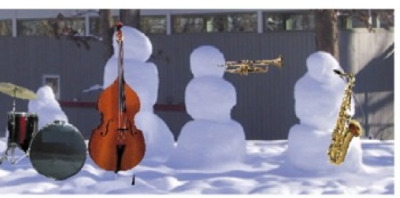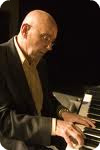Rifftides: February 2010 Archives
After three years of keeping his alto saxophone in the closet, in 1974 Paul Desmond finally succumbed to the exhortations of the Canterino family and agreed for the first time in a quarter of a century to play a club date as leader. The Canterino's club, the Half Note, had moved from lower Manhattan to Midtown. The new proximity was an important factor. "After all," he told me, "It's only a couple of blocks away. I can fall out of bed and onto the bandstand." He hired Jim Hall on guitar, Ron Carter on bass and drummer Ben Riley. For two weeks, they played opposite the Bill Evans Trio.
Desmond enjoyed it so much that he wanted to do more quartet playing. He had been thinking about going to Canada. Hall told him about a Toronto guitarist named Ed Bickert and a club called Bourbon Street. Following negotiations, he went into the club with Bickert, bassist Don Thompson and drummer Terry Clarke, later replaced by Jerry Fuller. It was the group that became his beloved Canadian Quartet, and he played with them the rest of his life.
The young woman speaking with Desmond in the January, 1976, video below is the skilled interviewer Mary Lou Finlay, then the host of the Canadian Broadcasting Company's Take 30. In the full program, the actor and jazz enthusiast Paul Soles fills Finlay in on Desmond's career and on jazz, about which she confesses to know nothing. Then, in a pre-recorded studio video, the Canadian quartet plays "Wendy," followed by Finlay chatting with Paul live. It is a pity that YouTube doesn't offer the full segment, but at least we have a rare instance of Desmond speaking on television. The clip picks up after Finlay has asked him why the Dave Brubeck Quartet disbanded in 1967.
Desmond recorded this album with the Canadian Quartet at Bourbon Street. Chapters 32-34 of Take Five: The Public and Private Lives of Paul Desmond cover the Canadian period and the final 16 months of Desmond's life. He died on Memorial Day,1977.
The Rifftides Department Of Language Reform (DOLR) has been neglecting its duties. Its members claim that their failure to stop the misuse of "absolutely" and "no problem" (see this archives post) discouraged them. At a staff meeting on the subject, the DOLRers moaned that they despair of succeeding where Fowler, Strunk, White, Bernstein, Ciardi and other titans of proper English usage have failed. They pointed out that people still say, "ya know" every few seconds; still say and write, "they" when they should use, "he" or "she;" millions still bloat their sentences with "on a daily basis" and "on a national basis," wasting words when they could streamline with, "daily" and "nationally."
"Never give up," I told them. "It's God's -- or Webster's -- work."
"Maybe we're being too fussy, too pedantic," they said. "Maybe the language is just taking its evolutionary course, and what sounds wrong today will be right tomorrow."
"Shut up and watch this," I explained.
Typography from Ronnie Bruce on Vimeo.
To learn more about the poet Taylor Mali, go here. Thanks to Bobby Shew for calling this delightful wig bubble to our attention.
The finest language is mostly made up of simple unimposing words. -- George Eliot
But if thought corrupts language, language can also corrupt thought. -- George Orwell
What words say does not last. The words last. Because words are always the same, and what they say is never the same. -- Antonio Porchia, Voces, 1943, translated from Spanish by W.S. Merwin
I wonder what language truck drivers are using, now that everyone is using theirs? -- Beryl Pfizer
In April of 2009, a Rifftides review of a Daryl Sherman CD failed to mention the album's lead song, "S'Mardis Gras." It also perpetuated the tray card's mis-naming of the bass player. Correcting those shortcomings is a fine excuse to again call attention to a CD that deserves more of it.
Daryl Sherman, New O'leans (Audiophile). Hurricane Katrina's assault on the Crescent City inspired Sherman to record this collection of songs, but it goes beyond the post-disaster blues to touch on many of the aspects that endear New Orleans to the world. HaroldArlen's "Ill Wind" was an obvious choice. Louis Armstrong's "Red Cap," Irving Berlin's "Shaking the Blues Away," Henry Mancini's "Moon River" and Dave Frishberg's "Eloise" may seem unexpected companions in a New Orleans tribute until you hear how Sherman and her colleagues use them to evoke the city. Rhodes Spedale's "S'Mardi Gras" needs no enhancement in that regard; it is a tour of Fat Tuesday locations and emotions. Guitarist James Chirillo and trumpeter Connie Jones are Sherman's best-known sidemen. Reed man Tom Fischer and bassist Al Bernard, misidentified as "Menard," are in the same league. Sherman plays piano on this drummerless date. The infectious good cheer in her voice will make you grin, except when she makes your eyes moist with "Mr Bojangles" and "Wendell's Cat."
It seems there's a new development every day in the saga of London's Abbey Road Studios. Today, the building is off the block - if it was ever on - saved by designation as a part of history. The Los Angeles Times has the story with a splendid recent photograph of the building and the crosswalk the Beatles made famous.
Why does Rifftides care? Scroll down to "Studios And Sound," February 21.
The Village Vanguard is observing its 75th anniversary this week. Joe Lovano and the band he calls Us Five are playing there through Sunday. I wish that I could attend. But I 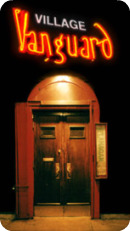 shouldn't be greedy; in my New York years, I was fortunate to be in the club often. I heard music there that echoes in my mind to this day. Frequently on Monday nights, I wrapped up the newscast, jumped into a cab and headed for the Vanguard. That's a night off for many musicians, and anyone might have shown up for the Thad Jones-Mel Lewis band in its weekly gig. Gene Ammons sat in one Monday when I was there, Sonny Rollins another. I missed the night in 1981, after the band had become the Mel Lewis Jazz Orchestra, when Miles Davis successively borrowed all the horns in the trumpet section and played on Jones's "Second Race." With or without a surprise guest, that band was a joy. Both of its its founders are gone and it is still a joy...every Monday night at the Vanguard.
shouldn't be greedy; in my New York years, I was fortunate to be in the club often. I heard music there that echoes in my mind to this day. Frequently on Monday nights, I wrapped up the newscast, jumped into a cab and headed for the Vanguard. That's a night off for many musicians, and anyone might have shown up for the Thad Jones-Mel Lewis band in its weekly gig. Gene Ammons sat in one Monday when I was there, Sonny Rollins another. I missed the night in 1981, after the band had become the Mel Lewis Jazz Orchestra, when Miles Davis successively borrowed all the horns in the trumpet section and played on Jones's "Second Race." With or without a surprise guest, that band was a joy. Both of its its founders are gone and it is still a joy...every Monday night at the Vanguard.
It was a pleasure to hang out during the breaks with the musicians at the bar or in the kitchen and to chat with Max Gordon. Max started the club in 1935 because he wanted a place where poets could read their work. Jazz came to the club later. On National Public Radio, Lara Pellegrinelli told a brief history of the Vanguard, Max and Lorraine Gordon (pictured) and some of the musicians who made a cultural institution of a triangular room in a New York Seventh Avenue basement. To read and hear her report, including the story of the foodless kitchen, go here.
wanted a place where poets could read their work. Jazz came to the club later. On National Public Radio, Lara Pellegrinelli told a brief history of the Vanguard, Max and Lorraine Gordon (pictured) and some of the musicians who made a cultural institution of a triangular room in a New York Seventh Avenue basement. To read and hear her report, including the story of the foodless kitchen, go here.
Happy birthday, Village Vanguard, and many more.
According to Norman Lebrecht, the proprietor of artsjournal.com's Slipped Disc, financial tap dancing led to reports that Abbey Road studios was--or might be--for sale. That does not invalidate the sonic issues raised in this February 21 Rifftides post. It may relieve the anxieties of audiophiles who cherish the great old studios. To read Mr. Lebrecht's followup, go here.
Unexpected and welcome news from a Danish web site: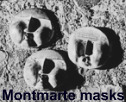
Denmark's once legendary jazz club Montmartre re-opens in May 2010 in its original premises in Copenhagen. During the 1960's and 70's the club served as a European home for American giants like Ben Webster, Dexter Gordon, Stan Getz, Kenny Drew and many others.
Pianist Niels Lan Doky and a partner will operate the club as a nonprofit enterprise. For details, go here. For recent Rifftides posts involving the Montmartre, go here and here.
Jazz At Lincoln Center has just announced the artists posthumously inducted into its Nesuhi Ertegun Jazz Hall of Fame for 2010. They are Bill Evans, Bud Powell, Billy Strayhorn and Sarah Vaughan. Those honored are chosen by vote of a panel of experts from 17 countries.
Jazz at Lincoln Center will present concerts dedicated to the inductees. Here is the schedule:
Intuition: The Music of Bill Evans (May 14-15, 2010)
The Music of Billy Strayhorn (November 5-6, 2010)
The Music of Sarah Vaughan (January 21-22, 2011)
The Music of Bud Powell & Earl Hines (April 29-30, 2011)
Hines was a previous winner, as were 34 others including Louis Armstrong, Billie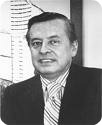 Holiday, Gil Evans, Fats Waller, Ella Fitzgerald, Miles Davis, Mary Lou Williams and Jo Jones. To see the entire list and their photographs, visit the Ertegun Hall of Fame site. The hall is named for the distinguished producer of recordings by musicians from Kid Ory to Ornette Coleman. It was funded by his brother Ahmet, Nesuhi's partner in Atlantic Records. Nesuhi Ertegun (pictured) died in 1989, Ahmet in 2006.
Holiday, Gil Evans, Fats Waller, Ella Fitzgerald, Miles Davis, Mary Lou Williams and Jo Jones. To see the entire list and their photographs, visit the Ertegun Hall of Fame site. The hall is named for the distinguished producer of recordings by musicians from Kid Ory to Ornette Coleman. It was funded by his brother Ahmet, Nesuhi's partner in Atlantic Records. Nesuhi Ertegun (pictured) died in 1989, Ahmet in 2006.
In the right hands, the accordion can be a wonderfully evocative instrument. To name a few jazz masters of the accordion: George Shearing, Joe Mooney, Eddie Monteiro, Pete Jolly, Ernie Felice, Angelo DiPippo, Tommy Gumina, and Sivuca, whose harmonic and rhythmic use of the accordion enhanced so much fine Brazilian music. Gus DeWert was a splendid accordionist from Kansas City. In his time, Art Van Damme may not have reached the general fame of Dick Contino ("Lady of Spain"), but he was immensely popular. Rifftides contributor Paul Conley of Capital Public Radio in Sacramento, California, prepared a report on Van Damme, who died last week on the threshold of his tenth decade. To listen to Paul's piece, click here.
In the wrong hands, the accordion can be reduced to an object of ridicule and cruelty so universal that there is a web site solely devoted to accordion jokes.
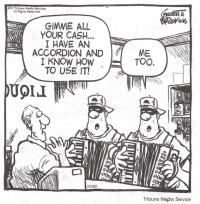
For fifty years, the master of cordeen humor has been Pete Barbutti, a triple-threat musician and a comic capable of reducing audiences to helplessness with his accordion routines. Here is his most famous one, from a Tonight Show broadcast during the program's Johnny Carson zenith.
 For more on the sound quality issues raised in the following exhibit (February 21), see the comments that piece has stimulated (click on the Comments button at the end of the item). Also, go here for a golden oldie updating news about Roy DuNann, a late-20th-century hero of recorded sound. That post, in turn, will link you back to the original DuNann installment from March, 2007. Welcome to the Rifftides time machine.
For more on the sound quality issues raised in the following exhibit (February 21), see the comments that piece has stimulated (click on the Comments button at the end of the item). Also, go here for a golden oldie updating news about Roy DuNann, a late-20th-century hero of recorded sound. That post, in turn, will link you back to the original DuNann installment from March, 2007. Welcome to the Rifftides time machine.
The staff looks forward to your comments on current and past entries.
In their list of priorities, most serious listeners put music's content before the quality of its sound. In one of our listening sessions at my house, I apologized to Paul Desmond for the scratchy surface of the old vinyl LP I was playing for him. "I don't care if it's recorded on cellophane strips," he said, "as long as I can hear what everybody's doing." Nonetheless, Desmond's own playback equipment was state of the art. He preferred first-class audio.
 The Desmond episode came to mind as I read Eric Felten's Wall Street Journal "De Gustibus" column about the importance of studios to the enjoyment of recorded music. Felten used as his point of departure the report that EMI may sell its Abbey Road Studios. Musicians venerate Abbey Road for the sound quality of recordings made there not only by the Beatles, Radio Head, Duran Duran and dozens of other pop performers but also by classical artists. Sir John Barbirolli conducted the premiere performance of Vaughan Williams' Symphony No. 5 at Abbey Road. French Horn virtuoso Dennis Brain recorded the Mozart Quintet for Piano and Winds there.
The Desmond episode came to mind as I read Eric Felten's Wall Street Journal "De Gustibus" column about the importance of studios to the enjoyment of recorded music. Felten used as his point of departure the report that EMI may sell its Abbey Road Studios. Musicians venerate Abbey Road for the sound quality of recordings made there not only by the Beatles, Radio Head, Duran Duran and dozens of other pop performers but also by classical artists. Sir John Barbirolli conducted the premiere performance of Vaughan Williams' Symphony No. 5 at Abbey Road. French Horn virtuoso Dennis Brain recorded the Mozart Quintet for Piano and Winds there.
Now, any 18-year-old tenor saxophonist with a computer and a bedroom can be a record company. Felten argues that the loss of the great studios to digital wizardry has resulted in homogenization and a leveling of individuality in recorded sound.
The digital-recording revolution has allowed producers armed with laptops and a few padded rooms in a basement to forgo the expensive environs of the traditional recording hall. Yet this comes at a cost.
Felten singles out the lamented Columbia 30th Street Studio as an example of what we have lost.
The airiness of classic '50s jazz owed much to the acoustic properties of an old Armenian church in Manhattan converted by Columbia Records into its 30th Street Studio.
Miles Davis's masterpiece, Kind of Blue, was recorded at 30th Street, and so too, just a couple of months later, was Dave Brubeck's album Time Out. David Simons, in his book Studio Stories, suggests that the success of those two records owed something to how they sounded, something that wasn't just a function of the quality of the recording equipment. There was the sympathetic resonance of the studio's unvarnished wood floor and the distant reverberations reflected by its towering ecclesiastic architecture: "To hear 30th Street is to hear drummer Joe Morello's snare and kick-drum shots echoing off the 100-foot ceiling during the percussion break in Dave Brubeck's great 'Take Five.'"
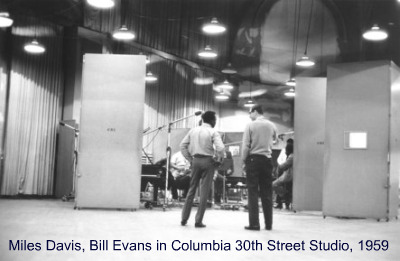
Much of the intimacy and warmth of Charles Mingus's Mingus Ah-Um (another masterpiece from 1959) and many of Thelonious Monk's Columbia records also came from the unique properties of the 30th Street Studio. The same can be said of how RCA's Studios A and B benefited recordings like Mingus's Tijuana Moods, Desmond's quartet albums with Jim Hall and the Juilliard String Quartet's recordings of Debussy, Ravel and Webern. You don't get that kind of sound with a laptop in your bass player's rec room.
To read all of Felten's thought-provoking column, including his reflections on the dread Auto-Tune, go here.
Rifftides reader Lauren Kesner O'Brien writes from New Orleans:
I'm the founder of a new video magazine, www.telegraph21.com, and am contacting you because all week we are featuring great videos about jazz and New Orleans. In particular I thought today and tomorrow's video feature, The Sound After the Storm, featuring well known musicians Lillian Boutté and Dr. Michael White would be of particular interest to your blog readers:
http://www.telegraph21.com/video/the-sound-after-the-storm
If it has been a while since you've heard these exemplars of modern New Orleans music, now in their 32nd year, here's your chance. It's Astral Project on the road last fall at the Artists Quarter in St. Paul, Minnesota. The band is Tony Dagradi, tenor (and at the end soprano) saxophone; Steve Masakowski, guitar; James Singleton, bass; Johnny Vidacovich, drums. The name of the post-Katrina piece is "Dike Finger." Think about it.
(All right, the headline is a cheap play on words. I tried to resist.)
Speaking of Dawn Clement (see the next exhibit), Jim Wilke will broadcast her trio in concert next Sunday, February 21, at 1 PM Pacific Standard Time. It will be on Wilke's Jazz Northwest program on KPLU-FM, the Seattle-Tacoma jazz station. He recorded the concert, which was part of the Seattle Art Museum's Art of Jazz series. The trio is Ms. Clement, piano; Geoff Harper, bass; Jazz Sawyer, drums. Seattle-area listeners can hear it at 88.5 FM. Internet listeners will find it at kplu.org
concert next Sunday, February 21, at 1 PM Pacific Standard Time. It will be on Wilke's Jazz Northwest program on KPLU-FM, the Seattle-Tacoma jazz station. He recorded the concert, which was part of the Seattle Art Museum's Art of Jazz series. The trio is Ms. Clement, piano; Geoff Harper, bass; Jazz Sawyer, drums. Seattle-area listeners can hear it at 88.5 FM. Internet listeners will find it at kplu.org
Jane Ira Bloom, Mental Weather (Outline). This 2008 quartet album by the soprano saxophonist deserved Rifftides attention long before now. Bloom is noted for her control, 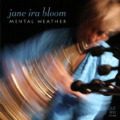 intonation and full-bodied sound on a notoriously thin and cranky instrument, but those qualities merely serve her creativity, which is at a high level here. She teams with drummer Matt Wilson, bassist Mark Helias and pianist Dawn Clement. Electronic effects sparingly employed on a few tracks enhance the precision and clarity of Bloom's placement of lines and the freedom of her interaction with the rhythm section. Helias and Wilson solo impressively and, in Wilson's case, with his customary wit. Their contributions as ensemble players account for a good deal of the album's richness.
intonation and full-bodied sound on a notoriously thin and cranky instrument, but those qualities merely serve her creativity, which is at a high level here. She teams with drummer Matt Wilson, bassist Mark Helias and pianist Dawn Clement. Electronic effects sparingly employed on a few tracks enhance the precision and clarity of Bloom's placement of lines and the freedom of her interaction with the rhythm section. Helias and Wilson solo impressively and, in Wilson's case, with his customary wit. Their contributions as ensemble players account for a good deal of the album's richness.
Clement's playing in this collection further explains why musicians on both coasts are recruiting her for her craftsmanship and the imagination of her soloing. The tone and dynamic variation of her keyboard touch are important elements in her individualism. Clement and Bloom have an ability to anticipate one another that prevents splatter in the execution of a challenging concept like the metric escapades of the title tune. Bloom's compositions embrace the unsentimental romanticism of "Cello on the Inside" as well as the adventurism of "Electrochemistry," which is the sort of thing Lennie Tristano might be doing if he were still around. She wrote all of the pieces except "This Nearly Was Mine." Bloom plays the Rodgers and Hammerstein ballad unaccompanied in one ravishing chorus of melody. This one goes into the permanent collection.
Gerald Clayton, Two Shade (Decca). In one dimension, Clayton brings to mind predecessors like Junior Mance, Monty Alexander, Oscar Peterson and Bobby Timmons. The spirit and verve of that brand of full-bodied pianism come across powerfully in "Boogablues" and his vibrant take on "All of You, " among other tracks. He displays further aspects in the ethereal "Casiotone Pothole," incorporating harmonized wordless voices and just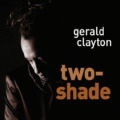 enough electronic manipulation not to do serious damage; the pointillism of "Trapped in a Dream;" and the prayerful quality of "Sunny Day Go," with its intimation of Chopin. Bassist Joe Sanders and drummer Justin Brown help make this a substantial debut album by a pianist who has developed dramatically in the decade since I first heard him as a 16-year-old sitting in with his father, the bassist John Clayton. His power, judgment, taste and maturity are evident in the integrated, cooperative nature of the trio. This band is the antithesis of piano with rhythm accompaniment. Still Clayton's six-minute performance alone of Dizzy Gillespie's "Con Alma" all but steals the CD. His ad lib introduction is a composition unto itself, the fruit of a fertile mind.
enough electronic manipulation not to do serious damage; the pointillism of "Trapped in a Dream;" and the prayerful quality of "Sunny Day Go," with its intimation of Chopin. Bassist Joe Sanders and drummer Justin Brown help make this a substantial debut album by a pianist who has developed dramatically in the decade since I first heard him as a 16-year-old sitting in with his father, the bassist John Clayton. His power, judgment, taste and maturity are evident in the integrated, cooperative nature of the trio. This band is the antithesis of piano with rhythm accompaniment. Still Clayton's six-minute performance alone of Dizzy Gillespie's "Con Alma" all but steals the CD. His ad lib introduction is a composition unto itself, the fruit of a fertile mind.
Harry Allen, New York State Of Mind (Challenge). Has Harry Allen been around so long now that people take him for granted? That would be a mistake. He is only 44. He got an early start. Great tenor playing is never out of style, and Allen has long since melded his primary influences--Ben Webster, Lester Young, Stan Getz, Zoot Sims--into an approach with 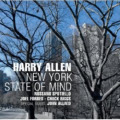 tonal and rhythmic qualities all his own. In this collection of songs about New York, he seems occasionally to also have Al Cohn on his mind. Allen's rhythm section is drummer Chuck Riggs, bassist Joel Forbes and the young Italian pianist Rossano Sportiello, who can manage in the course of one solo to evoke both Fats Waller and Al Haig. On six of the 11 tunes, the great trombonist John Allred is Allen's instrumental foil. Their romp through the elusive metering of Irving Berlin's "Puttin' on the Ritz" is nearly worth the price of the CD. Their out-of-tempo reading of the rarely-heard verse of "Autumn in New York" seals the deal. In his tag to "Broadway Melody," Allen comes about as close to quarter tones as a saxophone can handle. When is the last time you heard "Sidewalks of New York" or "Chinatown My Chinatown" as serious jazz vehicles? Not since Duke Ellington and Louis Armstrong? Maybe it's time to hear what updated harmonies can do for warhorses. Serious doesn't mean solemn.
tonal and rhythmic qualities all his own. In this collection of songs about New York, he seems occasionally to also have Al Cohn on his mind. Allen's rhythm section is drummer Chuck Riggs, bassist Joel Forbes and the young Italian pianist Rossano Sportiello, who can manage in the course of one solo to evoke both Fats Waller and Al Haig. On six of the 11 tunes, the great trombonist John Allred is Allen's instrumental foil. Their romp through the elusive metering of Irving Berlin's "Puttin' on the Ritz" is nearly worth the price of the CD. Their out-of-tempo reading of the rarely-heard verse of "Autumn in New York" seals the deal. In his tag to "Broadway Melody," Allen comes about as close to quarter tones as a saxophone can handle. When is the last time you heard "Sidewalks of New York" or "Chinatown My Chinatown" as serious jazz vehicles? Not since Duke Ellington and Louis Armstrong? Maybe it's time to hear what updated harmonies can do for warhorses. Serious doesn't mean solemn.
Terry Teachout, Pops: A Life of Louis Armstrong (Houghton Mifflin, 474 pages, $30)
A good biography of a musician makes the reader want to listen. Alexander Wheelock Thayer triggered that compulsion with his life of Beethoven, Marion Hildesheimer with Mozart, Richard Sudhalter with Bix Beiderbecke. Terry Teachout's Pops: A Life of Louis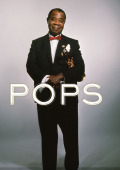 Armstrong can be a workout; all that getting up and down. Reading it, I repeatedly set aside the book to go to the shelves and exhume Armstrong recordings. Teachout evokes the essence of the artist. Here he is on the musicology and genealogy of "Muggles" by Armstrong and his Hot Five (1928):
Armstrong can be a workout; all that getting up and down. Reading it, I repeatedly set aside the book to go to the shelves and exhume Armstrong recordings. Teachout evokes the essence of the artist. Here he is on the musicology and genealogy of "Muggles" by Armstrong and his Hot Five (1928):
It is because of Armstrong's climactic two-chorus explosion that "Muggles" belongs to the ages. He charges in on (clarinetist Jimmy) Strong's heels with a two-bar break in which he doubles the tempo, proceeding directly to the most memorable of his many fantasias on one note, a chorus in which he rocks back and forth between a B-flat below middle C and the same note an octave higher, screwing up the tension to a pitch reminiscent of the last chorus of "West End Blues," then releasing it with a dark-blue phrase borrowed from Joe Oliver's solo on the Creole Jazz Band's 1923 recording of 'Jazzin' Babies Blues."
Teachout's discussion of "Stardust." (1931) is another instance of his ability to hook readers. Few could resist playing the recording as they read the author's transcription of Armstrong's vocal invention. Armstrong would have been as enchanted by that effect as Hoagy Carmichael was with the singer's interpretation.
...Armstrong's vocal is a paraphrase of Carmichael's tune and Parish's lyric, whose words he reshapes with a desentimentalizing freedom that delighted the composer: SometimesIwonderwhyIspendsuchlonely night (oh, baby, lonely nighnnmmmm) / Dreaming of a song (melody, memory) / And I am once again with you. Even for him it was a daringly imaginative transformation, much more so than the instrumental portion of the record, in which he mostly stays within earshot of the tune.
Teachout emphasizes in a hundred small and large ways that Armstrong accomplished his goal of making people happy, did it spectacularly, while producing music that set  artistic standards influencing American music to this day. His genius remade jazz from a collective folk form into a soloist's art and touched all areas of serious music. There is a bit of the influence of Armstrong in every aspect of popular culture, from three-chord rock and roll to no-chord free jazz, to the language and attitudes of fiction and the way certain actors move and speak on stage and screen. Great popular singers -- Billie Holiday, Bing Crosby, Frank Sinatra, Ella Fitzgerald -- would not have had their styles without Armstrong's example. Armstrong and the quintessential bebop trumpeter Dizzy Gillespie feuded over styles, but ultimately became good friends. Gillespie summed up the pervasiveness of Armstrong's sway: "No him, no me."
artistic standards influencing American music to this day. His genius remade jazz from a collective folk form into a soloist's art and touched all areas of serious music. There is a bit of the influence of Armstrong in every aspect of popular culture, from three-chord rock and roll to no-chord free jazz, to the language and attitudes of fiction and the way certain actors move and speak on stage and screen. Great popular singers -- Billie Holiday, Bing Crosby, Frank Sinatra, Ella Fitzgerald -- would not have had their styles without Armstrong's example. Armstrong and the quintessential bebop trumpeter Dizzy Gillespie feuded over styles, but ultimately became good friends. Gillespie summed up the pervasiveness of Armstrong's sway: "No him, no me."
As I wrote in selecting Pops as a Doug's Pick (center column), "Teachout combines with the advantage of unique access to Armstrong's archives deep musical understanding and the gift of writing clearly about complex matters." Those matters concern not only the workings of music but also of racism, politics and the Byzantine power economics of show business. Was Armstrong's longtime manager Joe Glaser an exploiter who had moorings in organized crime? Yes. Was he good for Armstrong? Yes. Teachout shows that the dependent psychological makeup formed by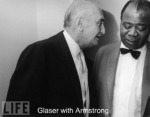 his background and reinforced by the advice of his mentor Joe Oliver, ordained that Armstrong have Glaser or a white man like him take care of business. He also makes clear that Armstrong knew about the outsized share of his money that Glaser was taking and accepted it as the price of the freedom to concentrate on his music and "always give a good show."
his background and reinforced by the advice of his mentor Joe Oliver, ordained that Armstrong have Glaser or a white man like him take care of business. He also makes clear that Armstrong knew about the outsized share of his money that Glaser was taking and accepted it as the price of the freedom to concentrate on his music and "always give a good show."
Was Armstrong as some blacks charged, a kowtowing Uncle Tom? No. He was a black man who grew up in a city where segregation could be vicious, and he was conditioned accordingly. Teachout presents evidence of outrageous incidents demonstrating that Armstrong's fame and visibility gave him no immunization against racist humiliation in the south or the north. One of his most demeaning mistreatments, when he was at his peak of renown, was not in Mississippi or Alabama, but when he was denied the use of a restroom in Connecticut. In 1957 when the chips were down for his people during the civil rights struggles in the south, he attacked President Eisenhower as "two-faced" and gutless for not enforcing the 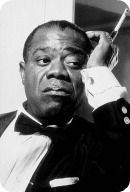 desegregation of Central High School in Little Rock, Arkansas. For good measure, he bestowed on Arkansas Governor Orval Faubus a scatological title. His angry outburst made headlines. Within days, Eisenhower ordered Federal troops into Little Rock to escort nine black children into the school. Teachout is persuasive in suggesting that, despite a lack of administration acknowledgement, pressure from news coverage of Armstrong's outspokenness played a role in forcing the Federal government to act.
desegregation of Central High School in Little Rock, Arkansas. For good measure, he bestowed on Arkansas Governor Orval Faubus a scatological title. His angry outburst made headlines. Within days, Eisenhower ordered Federal troops into Little Rock to escort nine black children into the school. Teachout is persuasive in suggesting that, despite a lack of administration acknowledgement, pressure from news coverage of Armstrong's outspokenness played a role in forcing the Federal government to act.
Through the access he was allowed, Teachout went more deeply into Armstrong's archives than was possible for previous scholars. A result of his research is that many of the most fascinating parts of Armstrong's saga come from his own writings and from hundreds of hours of reel-to-reel tape recordings. He was a constant writer and a tireless recordist of his thoughts, his household activities, his wife, his band members, his friends. He taped himself at home playing along with his classic recordings of the 1920s and '30s. Teachout works material from the tapes into the fabric of the book, adding new detail to one of the most unlikely of all rags-to-riches stories. He does not gloss over Armstrong's faults and foibles; a lifelong affair with marijuana, a string of troubled early marriages, a short temper. He balances the downsides with accounts of a mostly happy and faithful final marriage, a trail of generosity to friends and neighbors, reluctance to retain anger or hold many grudges, a keenly inquiring mind and the love of laughter.
As for Armstrong's beginnings in the rawest part of the underbelly of New Orleans, his introduction to music, the bloom of his genius and the globe-spanning arc of his life, Teachout tells the familiar and unfamiliar aspects of the story with the clarity and flow he brings to all of his writing.
In the eulogy at Armstrong's funeral in 1971, his friend Fred Robbins said, "he was truly the only one of his kind, a titanic figure in his and our time, a veritable Picasso. A Stravinsky. A Casals. A Louis Armstrong." Pops: A Life Of Louis Armstrong is persuasive and entertaining in support of that truth.
To see and hear the recent one-hour Brian Lamb interview of Terry Teachout on C-Span's Q&A, go to this archive video. Be patient; it loads slowly and has a false start, but once it gets underway it is proof that conversation on television can be illuminating. "Talking heads" needn't be a pejorative.
Critical carping and misguided stylistic arguments aside, in every period of his career Louis Armstrong was formidable in his playing and singing. His appearance with the All-Stars at the 1958 Newport Jazz Festival reminded many who had taken Armstrong for granted of the power of his art. Through Bert Stern's and Aram Avakian's film Jazz On A Summer's Day, his performance that night has reached untold thousands of listeners miles and years beyond the concert in Freebody Park.
The All-Stars were trombonist Trummy Young, clarinetist Peanuts Hucko, pianist Billy Kyle, bassist Mort Herbert and drummer Danny Barcelona. Jack Teagarden, Armstrong's brother under the skin, was a guest for "Rockin' Chair." Willis Conover made the introduction.
Drummer Jake Hanna died last night in Los Angeles of complications from a blood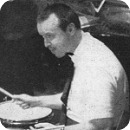 disease. He was 78. Versatile across all jazz styles, in small groups and large Hanna swung with unremitting flexibility and power. He was the spark plug of big bands led by Woody Herman, Maynard Ferguson and Harry James and worked with a score or more of small groups including Supersax and Toshiko Akiyoshi.
disease. He was 78. Versatile across all jazz styles, in small groups and large Hanna swung with unremitting flexibility and power. He was the spark plug of big bands led by Woody Herman, Maynard Ferguson and Harry James and worked with a score or more of small groups including Supersax and Toshiko Akiyoshi.
Here is Hanna in 1964 driving the Herman band in Bill Holman's arrangement of "After You've Gone." The video quality is a bit watery. The music is anything but.
In recent years, Hanna was in demand at jazz festivals and parties all over the US and abroad. To see and hear him jamming with trombonist Jimmy Cleveland, bassist Jeff Fuller, guitarist Bucky Pizzarelli, pianist John Bunch, cornetist Warren Vaché and tenor saxophonist Scott Hamilton, go here.
DevraDoWrite, aka Devra Hall, has a story about the time her father Jim played a trick on Hanna the trickster. To read it, go here.
Author Nick Catalano recently had occasion to revisit the JazzHouse in Copenhagen. The club is the 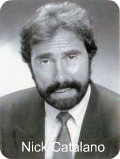 successor to the Montmartre, which presented dozens of the world's best jazz artists in the 1950s and '60s. Rifftides pieces about Bud Powell and the Montmartre's masks stimulated considerable comment. The staff thought you'd be interested in Nick's observations about the JazzHouse.
successor to the Montmartre, which presented dozens of the world's best jazz artists in the 1950s and '60s. Rifftides pieces about Bud Powell and the Montmartre's masks stimulated considerable comment. The staff thought you'd be interested in Nick's observations about the JazzHouse.
The atmosphere at Copenhagen JazzHouse is informal, the decor is charming and the crowd is serious. The room was packed on both nights and the audiences displayed that close attention which is so pervasive among European jazz patrons. People never whisper or otherwise distract listeners.
How refreshing. To read all of Nick's piece about the club before and since its reincarnation, go to his New York Beat column at All About Jazz.
Once in a great while, I encounter a photograph so good that it is necessary to dream up a reason to use it. In the case of the one beow, no dreaming was necessary. The lighting, sharpness and definition are so right, the shot looks like 3-D. The tenor saxophonist is Hadley Caliman. The conductor is Michael Brockman of the Seattle Jazz Repertory Orchestra. The SRJO is preparing for two concerts called Big Band Monk and Mingus, in early March.
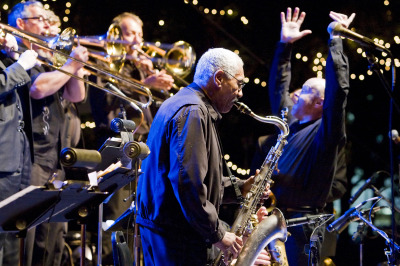
From the SRJO news release:
These concerts will feature rare performances of numerous historic works, including Thelonious Monk's "Bye-ya," Mysterioso" and "Evidence," and Charles Mingus' "Good-bye Porkpie Hat," "Shoes of the Fisherman's Wife," "Fables of Faubus," "Better Get Hit in Your Soul," "Don't Be Afraid, The Clown's Afraid Too," and "Self Portrait in Three Colors." The concert will feature original arrangements by Seattle jazz writer and pianist Bob Hammer for classic recordings by the Mingus Orchestra such as Mingus Ah Um and Let My Children Hear Music. Many of the Mingus works show off the lyrical side of his composition skills.
In tribute to the victims of the recent earthquake in Haiti, the SRJO will also perform Mingus' civil rights era work, Haitian Fight Song.
If you live in or near Seattle or find yourself in the neighborhood and haven't heard the SRJO, this would be a fine opportunity to get to know an impressive collection of musicians. For more information, go here.
There is little of the SRJO on web video, but here is a sample from an outdoor concert. Brockman's co-leader Clarence Acox introduces the piece. The trumpet soloist is Jay Thomas.
As for Hadley Caliman (remember the picture?), see this recent Rifftides item.
With fairness, it could be charged that Rifftides has been too concerned lately with the old and the dead. Well, certain observances and acknowledgements needed to be made. But let's move on. David Liebman wrote with an antidote. Here's his message:
ok--it's a cliche now that "they"(meaning the kids) get better earlier-check this out--he's already doing classical stuff since he was a babe--jazz for two years--Ravi (Coltrane) turned me on to him before I went to Israel a few weeks ago
13 yr old from Tel Aviv in a club there--just jammingwhat's next, out of the womb burning or what?
The 13-year-old's name is Gadi Lehavi. Now you know about as much about him as I do, except for how he plays "Autumn Leaves" with Dave Liebman. Here they are, less than a month ago.
The surest way to corrupt a youth is to instruct him to hold in higher esteem those who think alike than those who think differently.--Friedrich Nietzsche
It is all that the young can do for the old, to shock them and keep them up to date.--George Bernard Shaw
For God's sake give me the young man who has brains enough to make a fool of himself!--Robert Louis Stevenson
The young do not know enough to be prudent, and therefore they attempt the impossible -- and achieve it, generation after generation.--Pearl S. Buck
Youth is a quality, not a matter of circumstances.--Frank Lloyd Wright
I'll tell 'ya how to stay young: Hang around with older people.--Bob Hope
What three administrations in the White House have refused to do, the people have done. They have recognized Willis Conover, the Voice of America broadcaster who may have been America's greatest cultural diplomat of the Cold War. 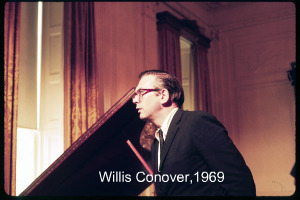 He now has his own Facebook page, The Willis Conover Club. Will that lead to his getting a long overdue posthumous Presidential Medal of Freedom? Possibly not, but his page, up only a day or two, is rapidly accumulating fans. One of them typifies the many musicians who huddled around their shortwave radios behind the Iron Curtain and were inspired by the jazz that Conover sent around the world during some of the most perilous decades of the 20th century. This is his message on the Conover Facebook page.
He now has his own Facebook page, The Willis Conover Club. Will that lead to his getting a long overdue posthumous Presidential Medal of Freedom? Possibly not, but his page, up only a day or two, is rapidly accumulating fans. One of them typifies the many musicians who huddled around their shortwave radios behind the Iron Curtain and were inspired by the jazz that Conover sent around the world during some of the most perilous decades of the 20th century. This is his message on the Conover Facebook page.
Dear everybody, Please join the Willis Conover Club, He had done for Jazz as much as Art Blakey, Duke Ellington, Horace Silver, Count Basie, Charlie Parker, Miles Davis, Dizzy Gillespie etc..... Valery Ponomarev
Ponomarev went on to migrate to the United States from the Soviet Union, play trumpet with Art Blakey and become an international jazz artist whose career continues. For background about Willis and a personal Rifftides recollection, go here. To read the many other items about Conover in this blog, go to the archives, click on "edit," then "find" and enter "Conover" in the search box.
Politicians and bureaucrats have downgraded the VOA to a remnant of its former power to objectively inform the world about the United States. Much of what Conover accomplished lingers in the good will he created toward his country with the music and dispassionate commmentary he disseminated for years by way of his Music USA program. In these daunting times, with the US so in need of good will, perhaps a swell of recognition from the bottom up will persuade the administration in Washington that cultural diplomacy is a potent tool.
If you are a Facebook member, enter Willis Conover in the Facebook search box. If you are not, you can go here to sign up.
Sad news from London that Johnny Dankworth --Sir John Dankworth-- has died at 82. The alto saxophonist, composer and band leader and his wife, the singer Cleo Laine, have been pillars of jazz in England since the early 1950s. To read the BBC's announcement of his death, go here.
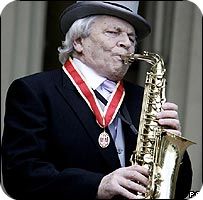
Browsing YouTube, I came across what must be among the rarest pieces of jazz film, a sequence of Woody Herman's Second Herd, the celebrated Four Brothers band. We hear Herman's vocal and a bit of Stan Getz's tenor saxophone on "Caldonia," then most of "Northwest Passage," both pieces holdovers from the First Herd destined to be staples in the Herman book for the rest of his life. Herman, Getz and Shorty Rogers play the trio section of "Northwest Passage," then there's a succession of four-bar solos by a guitarist, Getz, Al Cohn, Zoot Sims, Serge Chaloff, a trombonist and Herman.
The guitarist looks like Jimmy Raney, who was with the band from January to September of 1948. My guess is that the trombone soloist is Ollie Wilson. The alto saxophonist, who does not solo, is Sam Marowitz. Don Lamond is on drums. The pianist is most likely Fred Otis. I hope that knowledgable Rifftides readers can identify the bassist and confirm the identity of the pianist and the trombonist. Here's one of the greatest of all big bands:
Did I mention that it ends without ending? We take what we can get.
Rifftides Washington, DC, correspondent John Birchard has rediscovered pianist Mike Wofford and filed this appreciation:
I've been listening lately to Mike Wofford. I first heard his work on an Epic LP titled Strawberry Wine back in the early 60's and was impressed, especially with a couple of his originals, "Strawberry Wine" and "Three For All." In '67, he did another trio LP, Sure Thing, on Discovery, produced by Albert Marx, that I still have on my LP shelf. In '76, during the brief Scott Joplin revival associated with the movie "The Sting", Bob Thiele produced Scott Joplin Interpretations '76, a Joplin collection by Wofford, Chuck Domanico and Shelly Manne. That album's "A Real Slow Drag" comes highly recommended.
Time passed and I largely forgot about Wofford until I happened to see a CD by him recorded at San Diego's Athenaeum. I listened to it and was immediately a fan all over again. You're probably familiar with it, but he's accompanied by Peter Washington and Victor Lewis - and all three came to play. I love Wofford's version of "My Old Flame", as well as "Take the Coltrane", "Dex-Mex" and Conte Candoli's "Macedonia."Last week, wanting to hear more Wofford, I bought Holly Hofmann's CD
Minor Miracle, which also has Washington and Lewis on bass and drums. A little flute goes a long way with me, but Wofford's work makes the waits worthwhile. He is another of those musicians who have worked with many major figures, absorbed their influences and grown, and whose talent far exceeds their fame. I hope you agree.
-- John Birchard
I agree, heartily. I have had the Strawberry Wine LP since it came out in 1966 and listen to it frequently. Here is a section of the notes I wrote 30 years later for Bud Shank Plays the Music of Bill Evans, which has Wofford, Bob Magnusson and Joe LaBarbera in the rhythm section:
Shank calls Wofford a closet genius, but the pianist hardly keeps his talent under wraps. It is true that his visibility is in low ratio to his ability and the admiration of his peers. He left Los Angeles in the seventies, returned to San Diego and got a degree in philosophy at San Diego State University, but he never stopped working in music. He was Sarah Vaughan's accompanist for two years and Ella Fitzgerald's for four, putting him in a distinguished piano elite that includes Jimmy Rowles, Lou Levy and Tommy Flanagan.
Like virtually every jazz pianist of his generation, Wofford was heavily influenced by Bill Evans, a fact of which Shank took note in discussing Wofford's composition "Bill's Vane":
"Wofford was a Bill Evans fan," Shank says, "and for that reason the record was difficult for him. It's hard for piano players influenced by Bill to respect that period of their lives and not be imitators. He didn't want to revert to his Bill Evans period. He wanted to be Mike Wofford, but here he is playing this material he had spent all that time with 20 years before."
Wofford says, "I think this was some of my best playing."
It was. He didn't imitate Evans and doesn't imitate anyone else. He's been Mike Wofford for a long time.
For a selection of available Wofford CDs, go here.
In the clip below, we catch Wofford and Holly Hofmann dueting at home. The camera operator has trouble finding Wofford during much of his solo, but the audio quality is excellent.
For an extended example of why singers cherish Wofford as an accompanist, you'll find him in this video with the late bassist Andy Simpkins and drummer Harold Jones backing Sarah Vaughan at the 1984 Monterey Jazz Festival. YouTube has prohibited bloggers from embedding the Vaughan Monterey clips, but the site has additional videos of Vaughan's performance with the Wofford trio.
Daedalus Books and Music is a company that sells remaindered or overstocked books and recordings. It is the beneficiary of what we might conservatively call a state of flux in the fields of book publishing and recorded music. Daedalus and similar overstock specialists gather the fruits of catalogs thinned or, in some cases, decimated by publishers and record companies and sell them at reduced prices. The Winter 2010 Daedalus catalog includes 33 pages of cutout jazz, blues and rock CDs. All but a handful of the albums are on labels owned by Concord Music. In 2004, Concord bought the company that expanded from the little Fantasy label founded more than half a century ago in San Francisco by Max and Sol Weiss. Fantasy, Inc. already had under its umbrella the Fantasy, Riverside, Prestige, Pablo, Stax and Specialty labels, among others. Concord added its own catalog and acquired Telarc jazz and classics, to bring the total of labels under its ownership to 28, including subdivisions such as Original Jazz Classics and Concord Picante.
The cover of the catalog highlights these albums:
• Charlie Byrd's Homage to Jobim
• The Red Garland Quintet: Soul Junction
• Coleman Hawkins All Stars: Swingville
• Abbey Lincoln: Abbey Is Blue
• Sonny Rollins: Worktime
• Sylvia Syms: For Once In My Life
• The Dirty Dozen Brass Band: What's Going On
• The Riverside Folklore Series
Like most of the 225 albums Daedalus offers on those 33 pages, each of the CDs on that list is on a label of the Concord empire, except for the Dirty Dozen, which is on Shout Factory. A survey of the Concord catalog shows that many of the albums are still available from Concord as CDs, others only as MP3 downloads. Some have 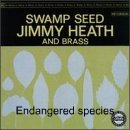 disappeared entirely from the Concord lists. Among the missing are precious items like Jimmy Heath's Swamp Seed and Cal Tjader Plays Harold Arlen & West Side Story, with its gorgeous Clare Fischer orchestral arrangements. Concord offers Sylvia Syms's For Once In My Life solely as a download. In fairness, I should emphasize that I had time only for a survey. You are free to go here and here and spend the hours (or days) it would take to do an item-by-item comparison of the Daedalus offerings with Concord's. Surely, Concord's web site must be a contender for the championship of extensive, exhaustive and challenging sites.
disappeared entirely from the Concord lists. Among the missing are precious items like Jimmy Heath's Swamp Seed and Cal Tjader Plays Harold Arlen & West Side Story, with its gorgeous Clare Fischer orchestral arrangements. Concord offers Sylvia Syms's For Once In My Life solely as a download. In fairness, I should emphasize that I had time only for a survey. You are free to go here and here and spend the hours (or days) it would take to do an item-by-item comparison of the Daedalus offerings with Concord's. Surely, Concord's web site must be a contender for the championship of extensive, exhaustive and challenging sites.
What's the point? Not to make a case against what appears to be the digital era's unstoppable dismantling of the recording industry as we have known it; I'll leave it to others to sweep back the tide. Not to bring business to Daedalus, which seems to be doing fine on its own. Not to warn Concord to be careful lest it fall of its own weight. The point is simply to alert Rifftides readers who may have been putting off acquiring valuable recordings in the belief that they will be available forever, or even later this year. This might be a good time to get those CDs, whatever the source.
unstoppable dismantling of the recording industry as we have known it; I'll leave it to others to sweep back the tide. Not to bring business to Daedalus, which seems to be doing fine on its own. Not to warn Concord to be careful lest it fall of its own weight. The point is simply to alert Rifftides readers who may have been putting off acquiring valuable recordings in the belief that they will be available forever, or even later this year. This might be a good time to get those CDs, whatever the source.
I hope that the Library of Congress or the Institute of Jazz Studies is archiving the Concord catalog. Many of the recordings in it are vital documents of American culture. It would be a shame for them not to be preserved.
GOING
To repeat: I have no intention of Rifftides becoming an obituary service, but as James Moody says his grandmother told him, "Folks is dyin' what ain't never died before," and some passings demand to be observed.
John Norris died yesterday in Toronto at the age of 76. He was the founder of the Canadian jazz magazine Coda, and of Sackville Records. Norris was a benevolent and resolutely independent spirit in music north of the border. He steadfastly resisted technological demands of not only the 21st century but also many of the 20th. To the frequent frustration of his correspondents, he eschewed both computers and fax machines, but he somehow managed to keep up with music and produce valuable recordings. His roster of Sackville artists was varied. It included Ed Bickert, Don Thompson, Benny Carter, Terry Clarke, Julius Hemphill, Ben Webster, Dick Wellstood, Archie Shepp, Ralph Sutton, Jay McShann, Ronnie Matthews, Geoff Keezer and Junior Mance, to name a very few. According to longtime Toronto broacaster Ted O'Reilly, Norris's wife Sandy will schedule a memorial service. For more about John Norris, click here.
technological demands of not only the 21st century but also many of the 20th. To the frequent frustration of his correspondents, he eschewed both computers and fax machines, but he somehow managed to keep up with music and produce valuable recordings. His roster of Sackville artists was varied. It included Ed Bickert, Don Thompson, Benny Carter, Terry Clarke, Julius Hemphill, Ben Webster, Dick Wellstood, Archie Shepp, Ralph Sutton, Jay McShann, Ronnie Matthews, Geoff Keezer and Junior Mance, to name a very few. According to longtime Toronto broacaster Ted O'Reilly, Norris's wife Sandy will schedule a memorial service. For more about John Norris, click here.
COMING
Thanks to Tony Emmerson's blog Prague Jazz, I learned of a young band called the Infinite Quintet. Based on their videos, it seems that they are nurturing the modern jazz legacy established by such predecessors as Karel Velebný, George Mraz, Emil Viklický and Karel Růžička.
The band is Petr Kalfus, alto and soprano saxophones; Miroslav Hloucal, fluegelhorn; Viliam Beres; piano; Petr Dvorsky, bass; and Martin Novak, drums. Here they are in a video from Czech television.
For other videos of the Infinite Quintet, go here.
AJ Ads
AJ Blogs
AJBlogCentral | rssculture
Terry Teachout on the arts in New York City
Andrew Taylor on the business of arts & culture
rock culture approximately
Laura Collins-Hughes on arts, culture and coverage
Richard Kessler on arts education
Douglas McLennan's blog
Dalouge Smith advocates for the Arts
Art from the American Outback
Chloe Veltman on how culture will save the world
For immediate release: the arts are marketable
No genre is the new genre
David Jays on theatre and dance
Paul Levy measures the Angles
Judith H. Dobrzynski on Culture
John Rockwell on the arts
innovations and impediments in not-for-profit arts
Jan Herman - arts, media & culture with 'tude
dance
Apollinaire Scherr talks about dance
Tobi Tobias on dance et al...
jazz
Howard Mandel's freelance Urban Improvisation
Focus on New Orleans. Jazz and Other Sounds
Doug Ramsey on Jazz and other matters...
media
Jeff Weinstein's Cultural Mixology
Martha Bayles on Film...
classical music
Fresh ideas on building arts communities
Greg Sandow performs a book-in-progress
Harvey Sachs on music, and various digressions
Bruce Brubaker on all things Piano
Kyle Gann on music after the fact
Greg Sandow on the future of Classical Music
Norman Lebrecht on Shifting Sound Worlds
Joe Horowitz on music
publishing
Jerome Weeks on Books
Scott McLemee on books, ideas & trash-culture ephemera
theatre
Wendy Rosenfield: covering drama, onstage and off
visual
Public Art, Public Space
Regina Hackett takes her Art To Go
John Perreault's art diary
Lee Rosenbaum's Cultural Commentary

